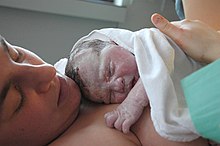Postpartum period
The postpartum (or postnatal) period begins after childbirth and lasts for six weeks after birth.[1]

There are three phases of the postnatal period:
- The acute phase: lasting for six to twelve hours after birth
- The subacute phase: lasting six weeks
- The delayed phase: lasting up to six months.
The World Health Organization (WHO) says that the postnatal period is the most critical and the most ignored phase in the lives of mothers and babies.[2] Most maternal and newborn deaths happen during this period.[2]
A woman giving birth may leave as soon as she is medically stable, which can be as early as a few hours postpartum. However the average for a vaginal birth is one to two days. The average caesarean section postnatal stay is three to four days.[3] During this time, the mother is checked for bleeding, bowel and bladder function, and baby care. The infant's health is also checked.[4]
Many organizations recommend routine postpartum evaluation at certain times in the postpartum period.[5]
The delayed postpartum period starts after the subacute postpartum phase and lasts up to six months. During this time, muscles and connective tissue returns to a pre-pregnancy state. Recovery from childbirth problems such as urinary function are typically very slow and in some cases may not resolve. Symptoms of PTSD often disappear in this period.[6] During this period, infant sleep during the night increases and maternal sleep usually improves.[7]
During the subacute postpartum phase, psychological problems may show up such as postpartum depression, post-traumatic stress disorder, and in rare cases, psychosis.[8] Postpartum mental illness can affect both mothers and fathers, and is not uncommon.[9]
References
change- ↑ Lopez-Gonzalez DM (2023). "Postpartum Care of the New Mother". StatPearls. PMID 33351433.
- ↑ 2.0 2.1 WHO Recommendations on Postnatal Care of the Mother and Newborn. World Health Organization. 2013. ISBN 9789241506649. PMID 24624481. Archived from the original on 20 January 2022. Retrieved 12 March 2022.
- ↑ "Recovering from a caesarean section". NHS Choices. Archived from the original on 20 December 2016. Retrieved 16 December 2016.
- ↑ Vernon D (2007). With Women, Midwives Experiences: from Shiftwork to Continuity of Care. Canberra: Australian College of Midwives. p. 17. ISBN 978-0-9751674-5-8.
- ↑ "ACOG Committee Opinion: Optimizing Postpartum Care". May 2018. Archived from the original on April 28, 2020. Retrieved April 29, 2020.
- ↑ Alder J, Stadlmayr W, Tschudin S, Bitzer J (June 2006). "Post-traumatic symptoms after childbirth: what should we offer?". Journal of Psychosomatic Obstetrics and Gynaecology. 27 (2): 107–112. doi:10.1080/01674820600714632. PMID 16808085. S2CID 21859634.
- ↑ McGuire E (July 2013). "Maternal and infant sleep postpartum". Breastfeeding Review. 21 (2): 38–41. PMID 23957180.
- ↑ Dobson V, Sales B (2000). "The Science of Infanticide and Mental Illness". Psychology, Public Policy, and Law. 6 (4): 1098–1112. doi:10.1037/1076-8971.6.4.1098.
- ↑ "Postpartum Depression". Canadian Mental Health Association. Archived from the original on July 14, 2014. Retrieved July 9, 2014.